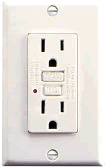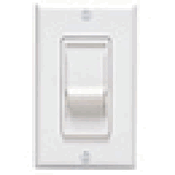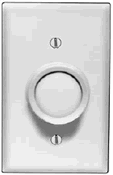Frequently
Asked Questions
Q: How do I reset a breaker?
A: Normally when a breaker trips, it does not go to the off position;
it only goes about halfway. You must turn the breaker all the way
to the off position and then turn it on. This goes for GFCI and AFCI
type breakers as well.
Q: Which of my outlets are protected by GFI’s?
A: All bathroom outlets, kitchen counter outlets and garage outlets
(within 6’ of water), that are not dedicated circuits, and any
outlets outside your house are GFI protected. The bathroom outlets
are tied together and no other outlets work off these. The kitchen
outlets don’t operate any other GFCI protected area other than
in the kitchen area. The garage GFCI normally works the outside outlets
as well. Remember: do not plug a refrigerator or freezer into a GFCI
protected outlet. This will cause it to trip. Backyard fountains can
also make the GFCI trip and should be on a separate circuit like the
garage refrigerator and freezer.
To reset your GFCI’S, unplug all devices, and press the reset
button to restore power to the outlets.
gfci receptacle
Q: When should I change my batteries in my smoke detectors?
A: The manufacturer recommends you get in the habit of changing your
batteries twice a year when you change your clocks for daylight savings.
Q: What type of batteries should I use?
A: Replace with Alkaline type Eveready Energizer #522, Duracell MN1604,
Carbon-Zinc type Gold Peak #1604P, Eveready #216.
Q: What do I do when my smoke detectors chirp?
A: The first thing to do is change all batteries. Even if you moved
in recently, your batteries could be run down due to construction
trades turning off the power for a number of reasons. You must change
all batteries, not just a few because all of your smoke detectors
are linked together and one bad battery could make all of them false
alarm. The second thing you can do is to get in the habit of vacuuming
your smoke detectors when you change the batteries because dust build-up
can also cause smoke detectors to false alarm.
Q: Why is one of the receptacles upside down?
A: It is common to find an outlet that is upside down in most of your
living areas or bedrooms. This is not a mistake. It is your switched
outlet or “half-hot” as it is also called. This is where
half of the outlet is constantly hot and a switch on the wall controls
the other half.
half-hot
Q: My lights dim when my neighbor’s AC goes on –
why?
A: This is typically an issue that is created by the location of your
home in relation to the utility transformer. The further away from
the transformer you are, the more likely you are to get a little dimming
of your lights. This is not harmful, it is just a little inconvenient.
Call your power utility company and ask them to come out to test the
meter. This is free of charge and it will determine if the voltage
drop is within their standards.
Q: Why do my fluorescent lights hum?
A: This is due to the ballast inside the fixture. It takes a few minutes
for the ballast to warm up and most of the time people finish with
whatever they are doing and turn the light off before it has time
to warm up and stop humming.
Q: Why do my fluorescent cans flicker?
A: Fluorescent cans have a starter for the lamp, and it is this starter
that causes the light to flicker until it has time to warm up.
Q: Why do my recessed cans turn off after they have been on
for a while?
A: Your recessed can lights have a built-in thermal protection device
that senses heat and shuts the light off to prevent overheating. The
most common reason for the overheating is that the insulation in the
attic is too close to the light and won’t let the heat escape.
Pulling the insulation back away from the light is something you may
choose to do yourself and does not require an electrical contractor.
Arc Fault Circuit Interrupter
Q: What is an Arc Fault Circuit Interrupter (AFCI)?
A: An AFCI is a device intended to mitigate the effects of arcing faults by functioning to de-energize the circuit when an arc fault is detected.
| Q: What can cause an arc? |
| A: |
- Frayed extension cords.
- Frayed cords on items such as lamps or stereo equipment.
- Furniture pressing against electric cords. |
Q: What areas of the home need AFCI protection?
A: AFCI breakers are required by code on all outlets in bedrooms.
This includes smoke detectors and fixtures.
This does not mean other outlets (not in bedrooms) can’t be AFCI protected, but they aren’t required to be by code.
Q: What about the nuisance tripping of the AFCI breakers?
A: We have come across items in homes that have caused AFCI nuisance tripping, such as vacuum cleaners, treadmills and space heaters. The way to avoid this is to use outlets not protected by AFCI such as, bathroom outlets or outlets in the dining and nook areas when using these types of items.
Q: How to test an AFCI breaker.
A: Manufacturers of the AFCI breakers state the only way to test an AFCI breaker is to push the test button on the breaker while it is in the “on” position. There are no “plug-in” type testers that are approved by the breaker manufacturers at this time.
Quick
Reference of the terminology for the types of receptacles
and switches you may find in your home
|
|

|
|
|
GFCI
Receptacle Duplex |
Receptacle |
Half-Hot
|
|
|
|
|
Toggle
Switch |
Rocker
Switch |
Slide
Dimmer |
|
|
|
|
|
Rotary
Dimmer |
|
Do you have another question that you would like to see answered on
the page? If so, please submit it to: CustomerService@HDElectric.com
|







